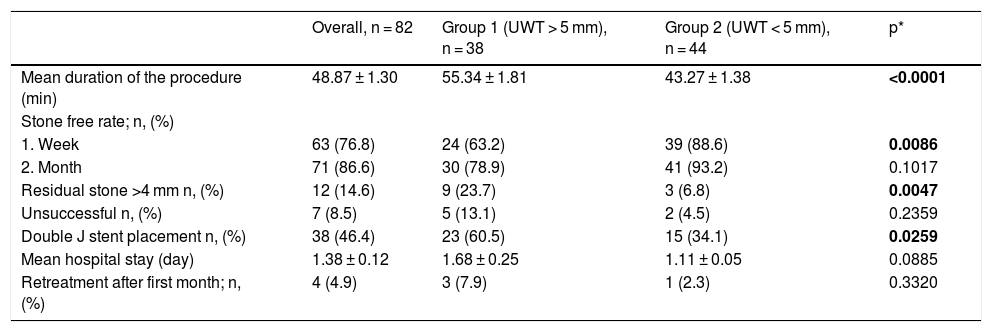To evaluate the possible impact of stone impaction in terms of ureteral wall thickness (UWT) on the success and procedure related parameters of ureteroscopic management in proximal ureteral calculi.
Patients and methods82 patients with proximal ureteric stones were included and were divided into two subgroups where UWT was >5 mm in 38 cases; and <5 mm in 44 cases. Stone size, degree of hydronehrosis, diameter of proximal ureteral lumen, UWT and patient's demographics were evaluated. Semi-rigid ureteroscopy with Ho-YAG laser was performed and the possible impact of UWT as an objective parameter for stone impaction on the success rates and procedure related parameters was evaluated.
ResultsMean patient age and stone size values were 47.55 ± 1.78 years and 8.17 ± 0.29 mm respectively. Regarding the impact of UWT value at the stone site for the parameters mentioned above stone free rates particularly at 1-week after the procedure was higher in group 2 and the rate of residual fragments as well as the need for double J stent placement was higher in group 1. Additionally, mean duration of the procedures was significantly longer in Group 1 during which pathologic alterations were significantly higher in ureteral wall at stone site were observed in these cases (p:0.0243).
ConclusionsUWT may be used to predict the success of ureteroscopic management and other procedure related parameters for proximal ureteral stones in an effective manner. With this approach a more rational operative plan with higher success rates, limited complications and auxiliary procedures could be made.
Evaluar la relación del espesor de la pared ureteral (EPU) con el éxito y parámetros relacionados con la ureteroscopia para el tratamiento de cálculos ureterales proximales.
Pacientes y métodosse incluyeron 82 pacientes con cálculos ureterales proximales y se dividieron en dos subgrupos de acuerdo con el grosor de la pared ureteral: un grupo con 38 pacientes, EPU > 5 mm; y el segundo con 44, EPU < 5 mm. Se evaluaron los siguientes parámetros: tamaño de la piedra, grado de hidronefrosis, diámetro de la luz ureteral proximal, el EPU y los datos demográficos de los pacientes. Se realizó ureteroscopia semirrígida con láser Ho-YAG y se evaluó el posible impacto del EPU sobre las tasas de éxito y los parámetros relacionados con el procedimiento.
ResultadosLa media de edad de los pacientes y el tamaño de los cálculos fue 47.55 ± 1.78 años y 8.17 ± 0.29 mm respectivamente. Con respecto al impacto del valor de EPU sobre los parámetros mencionados anteriormente, la tasa libre de cálculos una semana después del procedimiento fue mayor en el grupo 2 y la tasa de fragmentos residuales, así como la necesidad de colocación de catéter doble J, fueron mas altas en el grupo 1. Adicionalmente, la duración media del procedimiento fue significativamente más larga en el Grupo 1, y se observaron alteraciones patológicas en la pared ureteral significativamente mayores en estos casos (p: 0.0243).
Conclusionesel EPU es un factor útil al predecir el éxito del tratamiento ureteroscópico y otros parámetros relacionados con el procedimiento para los cálculos ureterales proximales. Con este enfoque, se podría realizar un plan operativo más adecuado, con mayores tasas de éxito, menos complicaciones y procedimientos adicionales.









